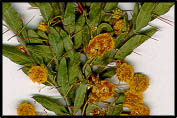South West Slopes Revegetation Guide
Acacia paradoxa
Hedge Wattle
Select from the following for detailed images.
Species Information
| Synonyms |
A. armata |
| Common Names |
Hedge Wattle, Kangaroo Thorn, Prickly Acacia, Wild Irishman |
| Family |
Mimosaceae - Mimosa family. |
| Name Origin |
paradoxa - from Latin paradoxus, contrary to the usual type. |
Specimen Data - CSU 647
| Location |
Goobang National Park, central section along creek valley south of Cookamobil Ridge. NSW |
| Notes |
Found in a valley in a open forest on a gentle slope in sandy loam soil. Zone: 55 Easting: 630707 Northing: 6353510 |
| Collector |
Lunt, Ian |
Date |
08/09/1999 |
| Determined By |
Lunt, Ian |
Date |
09/11/1999 |
South West Slopes Revegetation Guide Information
| Regional: |
Widespread in drier forests of most catchments and districts. |
| Australia: |
Qld, NSW, Vic, SA, WA. Introduced in Tas. |
| Habitat: |
Various communities and soils. |
| Habit: |
Erect or spreading shrub 2.5-4 m high. Dark green foliage, fine thorns and finely fissured brownish-grey bark. |
| Similar Species: |
|
| Site Preference: |
|
| Characteristics: |
Fast-growing. Lifespan up to several decades. Prickliness precludes grazing by livestock. May spread in some districts. |
| Flowering: |
Golden-yellow, July-Nov. |
| Seed Collection: |
Early Dec to mid Jan. Monitor closely as seeds released immediately or within 1-2 days of maturity. |
| Propagation: |
From scarified seed ( 75 viable seeds per gram). Pour boiling or very hot water over seeds and soak for several hours before sowing. |
| Regeneration: |
From seed after disturbance such as fire. Colonises steep bare banks in shallow soils. Readily established when direct seeded. |
| Timber: |
|
| Shade and Shelter: |
Useful low-level cover in windbreaks in districts where known not to spread. |
| Land Protection: |
Useful for controlling soil erosion due to soil-binding fibrous roots, and for improving soil fertility. Legume - improves soil fertility by 'fixing' nitrogen. |
| Wildlife: |
Excellent habitat. Very useful refuge and nesting sites for small birds, such as wrens and thornbills due to prickliness. Flowers are a food source for moths, \ butterflies and other insects. Insect-eating birds attracted. Seeds eaten by native birds, including parrots and native pigeons. |
| Ornamental: |
Attractive specimen for hedges, barriers, screening, tubs and as cut flower, for districts where it does not spread. Prune lightly after flowering to prevent straggly growth. Resents severe pruning. |
| Other: |
Attractive specimen for hedges, barriers, screening, tubs and as cut flower, for districts where it does not spread. Prune lightly after flowering to prevent straggly growth. Resents severe pruning. |
Note: The following information presented is only a guide, as plant characteristics vary depending on provenance (the plant's locality).
| Site/Preferred Habitat : |
dry shallow soils in high rainfall areas; heavier soils in lower rainfall areas |
| Rainfall(mm) : |
300 |
| Growth Rate : |
fast |
| Tolerates : |
moderate flooding; dryness; acid & alkaline soils |
| Resents : |
frost when young |
| Uses & Comments : |
windbreak; fixes nitrogen; erosion control; excellent wildlife habitat |
Return to Database List
